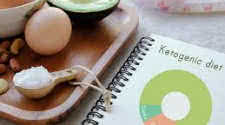Aerobic Exercise and Low Carbohydrate Diets

Advanced Exercise & Nutrition Science
Few people will dispute that muscle glycogen constitutes the primary fuel for anaerobic exercise, such as a typical bodybuilding workout. Intense debate will ensue, however, if you make the heretical statement that you can still train hard with few or no carbs. A new study
examined the effects of a very-low carb diet on aerobic-exercise performance. Published in the Journal of Physiology and Pharmocofogy (47:36 1 -371, 1996), the study measured indices of aerobic metabolism, such as maximal oxygen intake (V02 max) and lactate threshold, in eight
healthy, untrained subjects with an average age of 22. The lactate threshold is the point at which lactic-acid buildup induces fatigue. The eight men in the study consumed one of two diets: a control diet or a diet containing the same number of calories, but composed of SO% fat,
45% protein and 5% carbs. The percentage of carbs made this second diet a "ketogenic," or very-low-carb, diet.
Ketones are intermediate byproducts of fat metabolism that increase during low carb dieting, as well as in certain pathological conditions, such as uncontrolled diabetes. In the subjects ingesting the ketogenic diet, V02 max increased, as did fat burning during exercise.
Significantly, the lactate threshold shifted toward higher exercise loads; that is, blood lactic acid was lower before, during and after exercise when the men were on this diet. In addition, blood acidity increased, as did resting blood-kane levels and free fatty acids.
Analysis of hormones showed that levels of epinephrine, norepinephrine and cortisol increased both before and after exercise, while insulin decreased. The authors of the study concluded that "short-term ketogenic diets do not impair aerobic-exercise capacity as indicated by
elevate V02 max and lactate threshold." . The scientists conducting this study suggest that aerobic exercise isn't impaired while consuming a ketogenic diet because the body uses both ketones and free fatty acids as alternative energy sources. Also adding to the effect is the
increased flow of both epinephrine and narepinephrine, as well as cortisol. All three of these hormones increase free fatty acid release during exercise, whereas insulin prevents fatty acid release.
This study underscores at least two points. First, a reduction in carb intake appears to increase the use of fat during aerobic exercise. Second, drastically lowering carb intake for short periods will not adversely affect aerobic exercise. But what, about anaerobic exercise?
Other studies show that depleted muscle glycogen will not hamper anaerobic exercise as much as you'd expect, providing that a source of circulating blood glucose is available. Usually this glucose comes from liver glycogen stores, but a very-low-carb diet will deplete liver
glycogen in 12 hours - what happens then? If no carbs are available, the body will convert branched-chain amino acids stared in muscle into glucose in a process occurring in the liver called glucaneogenesis.
But this will only happen if you're consuming a low-protein diet, an uncommon regimen in bodybuilding circles. In most instances, the body will convert excess food protein - up to 57% of protein calories - into glucose. The biggest problem with low-carb diets is that if you
consume fewer than 50 grams of carbs a day, your body will convert active thyroid hormone (13) into an inert form called reverse 13. The body uses this device for protection against self-cannibalization. of tissue, such as muscle. Ketones also prevent muscle breakdown during
low-carb diets.
In practice, more modern versions of low-carb diets suggest a weekend break, during which consumption of greater amounts of carbs are permitted. This serves to replenish depleted liver and muscle-glycogen stores and to promote increased insulin - which, in turn, promotes
increased muscle-protein synthesis.